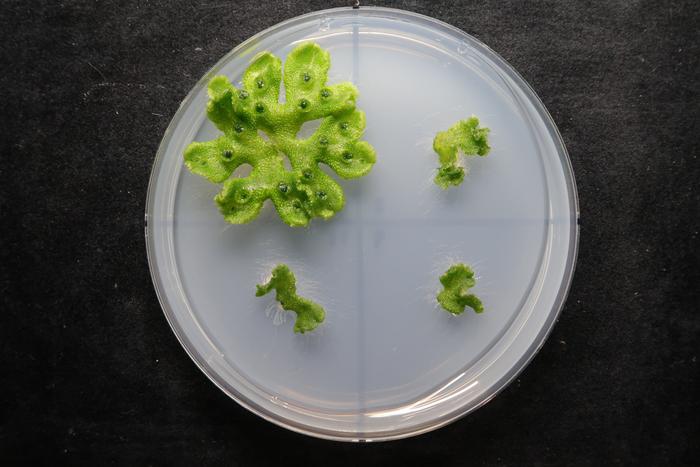In a groundbreaking study published in the journal New Phytologist, researchers at Kobe University have unveiled a remarkable discovery that deepens our understanding of plant evolution and organ development. The team, led by esteemed plant biologist FUKAKI Hidehiro, revealed that a gene previously known to regulate root development in vascular plants is also critically involved in organ formation in liverworts—ancient land plants that lack true roots. This finding not only challenges conventional views of plant developmental genetics but also offers compelling evidence of how evolutionary mechanisms repurpose existing genetic pathways to fulfill new biological roles.
The focal point of this investigation is a gene known as RLF, part of a gene family that had been implicated primarily in the lateral root formation of Arabidopsis thaliana, a widely used model organism in plant biology. While the RLF gene’s influence on root emergence in Arabidopsis was established, its broader role across the plant kingdom had remained elusive. Fukaki’s team hypothesized that if this gene is fundamental to organ development, then its function might be conserved even in basal land plants such as liverworts, which diverged early in the evolution of terrestrial flora and lack many complex structures found in flowering plants.
To test this hypothesis, the team turned to Marchantia polymorpha, a species of liverwort that serves as a model organism for studying primitive land plants. Unlike vascular plants, liverworts do not possess true roots that facilitate water and nutrient uptake. Nevertheless, Marchantia harbors its own version of the RLF gene, providing a unique experimental system to explore gene function at an evolutionary baseline. The researchers employed advanced genetic manipulation techniques to knock out the RLF gene in liverworts and observed striking developmental abnormalities. The mutants exhibited severe distortions in multiple organ structures, underscoring that RLF is essential for maintaining normal organ morphology even in these primitive plants.
One of the most compelling aspects of the study was demonstrating that the RLF genes from Arabidopsis and Marchantia are functionally interchangeable. Through gene complementation experiments, the Arabidopsis RLF gene was able to substitute for its liverwort counterpart and vice versa. This cross-species functional equivalence implies a deep evolutionary conservation of molecular mechanisms governing organ development, reaching back hundreds of millions of years to the earliest land plants’ ancestors.
At the molecular level, the RLF gene encodes a protein classified within a large family of heme-binding proteins similar to cytochrome b5. Heme, an iron-containing porphyrin, is critical in numerous cellular processes, including electron transport and energy metabolism. Prior to this work, heme-binding proteins had not been associated with plant organogenesis, making this discovery a paradigm shift in understanding how metabolic cofactors can influence developmental pathways. Fukaki and colleagues confirmed that the RLF protein indeed carries heme in both liverwort and Arabidopsis contexts, suggesting a conserved biochemical function that transcends structural differences between plant lineages.
The evolutionary implications of this study extend beyond the functional discovery. Liverworts evolved long before vascular plants developed complex root systems, indicating that mechanisms facilitating organ development existed prior to the emergence of roots as specialized organs. Fukaki asserts that the co-option of the RLF gene represents a classic example of evolutionary innovation where pre-existing genetic modules are repurposed to enable new functions—in this case, the evolution of roots. This finding echoes a broader principle in evolutionary biology: new traits often arise through the modification of ancient genetic circuits rather than the invention of entirely novel genes.
Understanding how RLF operates within the intricate network of plant developmental signals remains a key objective. The research team anticipates that decoding the protein-protein interactions mediated by RLF and exploring its integration with hormonal pathways could unveil further insights into the molecular underpinnings of organogenesis. Such knowledge has the potential to transform agricultural science by enabling targeted manipulation of root and shoot architectures to improve crop resilience and nutrient uptake efficiency.
The research methodology hinged on combining genetic editing tools, comparative genomics, and phenotypic analyses. The use of Marchantia as a model organism was pivotal, leveraging its simplicity and genetic tractability to unravel biological questions that are challenging to address in more complex plants. By bridging findings from a basal land plant and a flowering plant, the study offers a compelling narrative of continuity and innovation in plant evolution.
Funded by several programs including Japan’s Ministry of Education (MEXT) and the Japan Society for the Promotion of Science, the project epitomizes international collaborative efforts, with contributing researchers from multiple Japanese institutions such as the University of Tokyo and Osaka University. This interdisciplinary and cooperative approach underscores the importance of merging developmental biology, evolutionary genomics, and biochemistry to tackle fundamental questions about life’s diversity.
In sum, this pioneering study by Kobe University scientists not only elucidates a previously unrecognized role for a heme-binding protein in plant organ development but also contributes a key piece to the evolutionary puzzle of how complex multicellular structures arose in terrestrial plants. The discovery reiterates that ancient genetic elements, refined and redeployed through evolutionary time, continue to shape the living world and may hold untapped potential for future scientific and agricultural breakthroughs.
Thanks to this novel insight into RLF’s conserved function, the scientific community gains a fresh perspective on the molecular continuity underlying life’s complexity. As FUKAKI Hidehiro remarks, the discovery that RLF has played an essential role since the dawn of land plants illuminates the intricate weaving of evolutionary history and molecular function, inspiring new research into plant development and evolution’s broader mechanisms.
Subject of Research: Not applicable
Article Title: Evolutionary conserved RLF, a cytochrome b5-like heme-binding protein, regulates organ development in Marchantia polymorpha
News Publication Date: 25-May-2025
Web References: DOI 10.1111/nph.70181
Image Credits: FUKAKI Hidehiro
Keywords: RLF gene, liverwort, Marchantia polymorpha, organ development, plant evolution, heme-binding protein, cytochrome b5-like protein, Arabidopsis thaliana, root development, evolutionary conservation, plant genetics, molecular evolution




